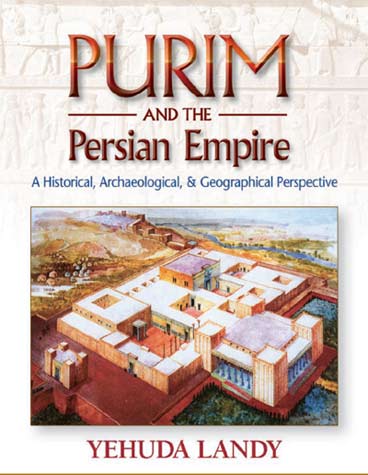
A Historical, Archaeological & Geographical Perspective
(Feldheim Publishers)
By: Yehuda Landy
Reviewed by: Fern Sidman
As Jews, we are blessed to enjoy the observance of many holidays; all of which are steeped in rich meaning, symbolism and profound lessons for life. We are taught that the one holiday that will endure forever, even after the coming of Moshiach and the final redemption will be that of Purim. As we immerse ourselves in the joy and gladness of Purim, we are also cognizant of the fact that the timeless and eternal story of Purim, as told in Megillas Esther, is one that genuinely embodies the resilience of the Jewish soul as manifested in total faith and hope in Hashem and the determination to survive against all odds.
In this recently published book, “Purim and the Persian Empire – A Historical, Archaeological & Geographical Perspective” (Feldheim Publishers), Rabbi Yehuda Landy, a noted Torah scholar, lecturer, author and archaeology expert examines the enigmatic qualities of Purim and answers the litany of questions that we have all pondered as he takes us on a trenchant sojourn into the fascinating world of the Persian Empire. Megillas Esther virtually comes to life as we gain a cogent understanding and new insights as we study excerpts of the text that are laden with Talmudic, historical and archaeological scholarship as evidenced in the presentation of ancient artifacts, maps and magnificent photographs.
This book is the culmination of a four-year research project which spanned three continents, as the author explains that his inspiration for this endeavor began on a visit to a special exhibition at the British Museum in London named “Forgotten Empire”, that dealt exclusively with the material culture from the same Persian Empire with which we are familiar from the Book of Esther. While this book is not “meant to resolve any halachic issues”, says the author, “it is meant as a tool for understanding and visualizing the events of the Megillah.” Beginning with a historical backdrop of the Persian Empire in Jewish history, the author informs us that after the conquest of the Babylonian empire by the kings of Persia and Media, life improved dramatically for the Jews as their new Persian rulers permitted them to return to their land and to “rebuild the Beis HaMikdash and the wall around Jerusalem.” While the darkness of the Babylonian exile had ended and Jews lived in relative freedom from oppression, it became clear that their new Persian rulers were not immune to strains of virulent anti-Semitic proclivities as manifested in the city of Shushan prior to the story of Purim.
The narrative is greatly enhanced by the stunning photos of original artifacts from that era which included clothing, cosmetics and furniture as well as the gold and silver tableware and drinking vessels from Achashverosh’s palace. We transform into time travelers as we embark of a guided tour of the cities of Shushan and Jerusalem in all their resplendent glory and are treated to spectacular visuals of the king’s gate, the courtyard of the women’s residence, the king’s treasuries, the inner courtyard and the king’s gardens among many other ancient sites of the empire.
The author delves into the chronology of the Persian empire according to Chazal and provides us with a historical backdrop of the reign of such Persian kings as Daryavesh (Darius the Mede), Coresh, Cambyses and Xerxes, who is also believed to have been the real Achashverosh. “Although his name was pronounced by the Greeks as Xerxes, the Persian pronunciation was Chashiarsh. Chashiarsh, when pronounced in Hebrew, turns into Achasverosh” says Rabbi Landy. A most intriguing and informative chapter on the archaeological evidence of such ancient cultures as Assyria, Babylonia and the Persian cities of Pasargadae, Shushan, Persepolis and Hamadan sheds light on the decadence of the era and the societal influences that held sway amongst the respective populations. “The earliest documented identification of Shushan appears in the diary of Benjamin of Tudela (1165). He also makes mention of the tomb of Daniel wihch is located there”, the author concludes.
Historical and archaeological material are the predicate for our study of Megillas Esther in the second part of the book. Citing numerous sources from mesechta Megillah in the Gemara as well as historical proof, we get a rare glimpse into the inner machinations of the mind of Achashverosh, the faith-based motivations of Queen Esther and Mordechai and the hatching of Haman’s diabolical scheme of annihilation of the Jewish people. Following the miracle of Purim, the author clues us in to what became of Esther and Mordechai. “The Jews of Persia had a tradition that Mordechai and Esther are buried in the city of Hamadan, which was the original capital of Media. The custom to visit their graves before Purim continues until this very day.”
This detailed account of the holiday of Purim will surely be a captivating treat for history buffs and a must read for anyone who wishes to slake their desire for Talmudic and historical knowledge of this juncture in the annals of Jewish history. We are left incredibly inspired; even breathless, as we witness Hashem’s miracles as they unfold before our very eyes and as we forge a personal connection to those who summoned up the kind of faith that has sustained our people since time immemorial.
















